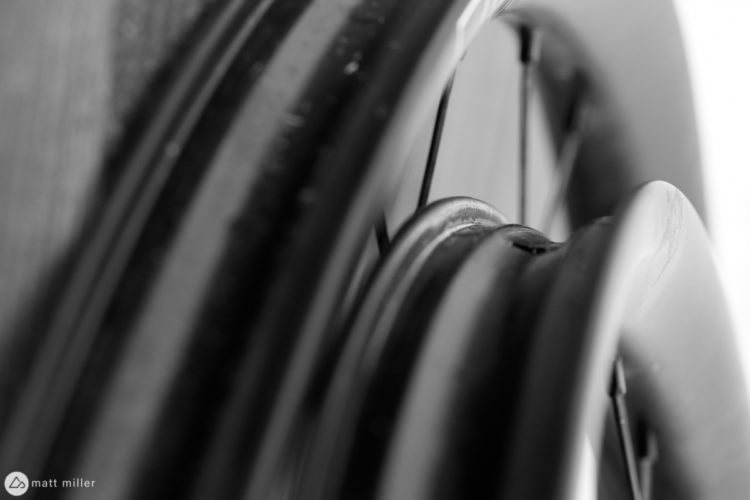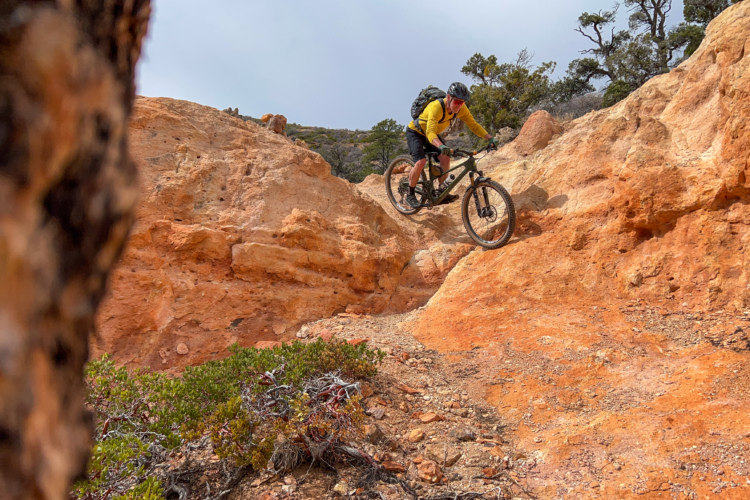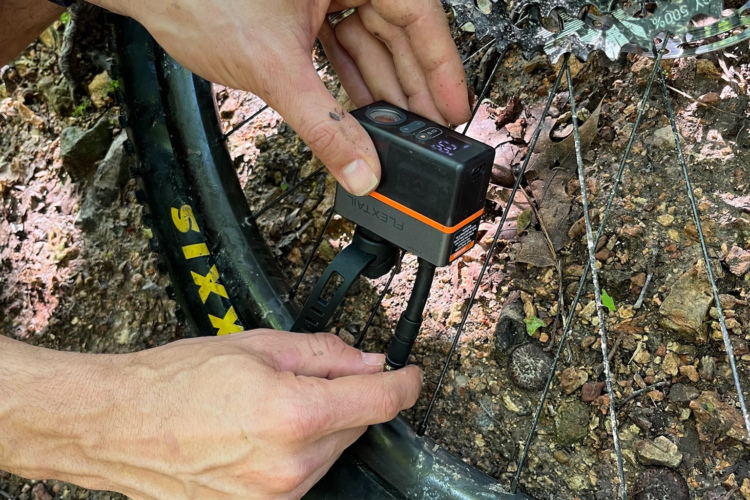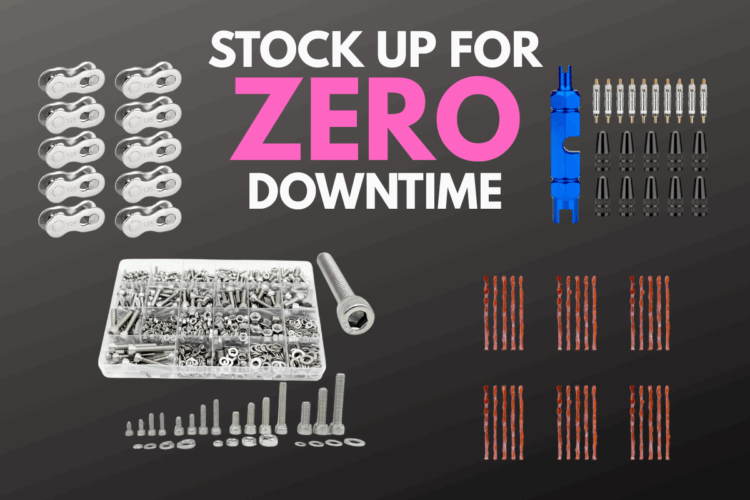
“Laterally stiff and vertically compliant.” That pretty much sums up the design brief for carbon mountain bike wheels over the past decade. It’s hard to say whether this mantra was marketing- or rider-driven, but looking back at Singletracks wheel reviews over the past five years, the Kool-Aid mustache is clearly visible.
“I like a wheelset without much lateral compliance,” Travis Reill wrote in this review of the Bontrager Line Elite 30 wheelset review last year. “Stiff wheelsets hold corners well, have me touching the brakes less, and inspire confidence overall.”
In this review of Stans Flow CB7 wheels, a set that boasts carbon rims with three times the lateral stiffness of equivalent aluminum rims, Gerow wrote, “Fortunately, the Flow CB7 wheels hold their lateral shape affirmatively, no matter what bike they’re on. Whether carving deep in a berm or hoping for traction across off-camber roots, the lateral stiffness adds useful precision to the bike’s front end.”
So it was surprising when, early last year, Race Face touted not lateral stiffness but compliance baked into their latest Era carbon wheelset. By September, Enve was making similar claims, saying that their fifth generation mountain bike wheelsets were roughly 50% less laterally stiff than their fourth generation wheels. (The M8 and M9 wheels saw even bigger vertical compliance gains, up to 77%.)
Which begs the question: is it better for mountain bike wheels to be laterally stiff or compliant? I decided to consult the experts to understand what’s going on, and as usual, the answer is more complicated and nuanced than the marketers’ talking points suggest. If we can say anything, it’s that the pendulum may have swung too far in the direction of lateral stiffness over the past decade, and carbon wheels are coming due for correction.

What is wheel compliance, and how is it determined?
Compliance is the ability of a mountain bike wheel to deform in response to an applied force. This can be determined using a simple test in a lab where wheel deflection is measured for a given amount of pressure applied. The opposite of compliance — stiffness — refers to a wheel’s ability to resist deformation.
When mountain bikers talk about carbon wheels, what we’re really referring to are wheelsets built with carbon rims. Bicycle wheels are complex systems that perform based on an interaction between the rim, spokes, and hub. Add in tires, with varying sizes, constructions, and pressures, and the picture gets even more complicated.
“You do have to look at it holistically,” said Matt Hornland, PR and Content Marketing Strategist for Race Face.
There isn’t a single compliance number that’s the right one for wheels, and even if there was, it would be impossible for designers to ensure it’s consistent across every tire configuration, let alone every bike frame and suspension setup. So, rather than target a specific compliance value in the lab, brands like Race Face and Enve look to riders to provide feedback on how a wheel feels on the trail and adjust from there.

What’s the difference between lateral and vertical compliance?
Put simply, lateral compliance measures how much a wheel deflects side-to-side in response to a force that’s applied perpendicular to the wheel’s direction of travel. In mountain biking, these forces tend to come into play when cornering as the wheel is tilted toward the ground and via side hits as tire and wheel pinball between rocks and roots.
Vertical compliance refers to how a wheel deforms up and down, for example, when landing a jump or encountering a square-edge hit. In the vertical direction, pedal forces have an effect as well, with cross-country riders, in particular, favoring more vertically stiff wheels to minimize bounce and maximize efficiency.

Carbon vs. aluminum rims
First and foremost, carbon rims promise weight savings compared to aluminum, though they need to be durable, too.
“People don’t necessarily think of carbon as durable right off the hop. It’s just a weight savings thing, but the reality is carbon is incredibly durable,” Hornland said. “You have a product that is meant to deform and act in a way that doesn’t take damage in the same way that an aluminum one does.”
Still, riders needed to be convinced, especially in the early days of carbon rims. Product designers engineered carbon rims so they were essentially indestructible, and slowly but surely, even the hardest chargers found carbon wheels to be durable enough for their needs.
“The big thing that was coming back was that if you make a bomb-proof wheel, it’s going to be pretty stiff. And the rims are doing a lot of that work,” Hornland said. On the flip side, “we were hearing the ride feel of aluminum was less harsh.”

The benefits of a more laterally compliant wheel
“Like many wheel manufacturers, in the past we understood vertical compliance of a wheel to be the source of improved ride feel,” Race Face wrote in the new Era wheelset sell sheet. However, based on additional testing and rider input, the design team came to the conclusion that a “comfortable ride feel in carbon wheels is the result of wheels flexing in the LATERAL plane, not just the vertical plane.”
Both Race Face and Enve say their pursuit of a more laterally compliant wheel is based on feedback from professional racers who are seeking an improved ride feel. More than once in our conversation, Hornland leans into the squishy concept of ride quality, which clearly can’t be measured in inches or pounds. On the surface, it sounds like a strange argument, especially in the context of professional mountain bike racing, where speed almost always takes a back seat to comfort.
In 2020, sponsored rider Amaury Pierron reportedly told Enve, “When I ride, I am looking so far down the trail, I need the bike to just move around everything while it’s underneath me. If I had wheels that could move around the rocks rather than bounce off of them, I could go faster.”
Enve connects the dots between ride feel and performance this way: “Increased compliance allows the rim to absorb vibrations in impacts, keeping the tire stuck to the ground. This increases grip in times when it’s needed most, like in braking bumps, blown-out corners, or rock gardens. The decrease in vibrations also lessens rider fatigue, allowing for longer and more competitive riding.” The argument is that increased compliance benefits all types of riders, from cross-country athletes experiencing less fatigue to gravity riders who gain more control and, hopefully, faster times.
Along these lines, “what is best for a World Cup-level DH pro is almost certainly not what’s best for the average mountain biker, even a pretty hardcore enthusiast,” Southern Wheelworks founder and former Singletracks contributor Dustin Gaddis told me.
With the Era wheelset, Race Face is mostly focused on delivering the lateral compliance that pro enduro riders say they want. “[Era] bridges into the trail category despite it being really aimed at all-mountain and enduro,” Hornland said. “So, are you going to take your enduro wheelset and expect it to feel like a cross-country wheelset? No, we have cross-country [specific] wheels.”
Aside from ride feel, adding compliance to a wheelset may also reduce the chance of pinch flats, though that’s really just a side benefit. In this review of Quai ISOS 33 enduro wheels, Gerow noted that while the wheels were laterally very stiff, “they do have enough give that I didn’t manage to flat any tires while testing them. Some rigid carbon rims won’t deflect or ovalize enough on impact, and all of the energy usually is taken up by the tire, resulting in a puncture.”
The thinking is that a compliant rim is able to get out of the way of the tire on impact compared to a more rigid design.

Drawbacks
Though increased rim compliance likely leads to fewer pinch flats, it could also cause wheels to wobble prematurely and increase wear and tear on spokes.
“The number one rule for keeping wheels true and not breaking spokes is [that] the spoke tension needs to be as high as possible, and as even as possible,” Gaddis said. He explains that whenever a rim flexes, spoke tension in the wheel drops, which causes fatigue and, eventually, spoke failure.
But what about performance? Circling back to those Singletracks wheel reviews, riders aren’t necessarily wrong when they suggest there’s a benefit to laterally stiff wheels. “Whether carving deep in a berm or hoping for traction across off-camber roots, the lateral stiffness adds useful precision to the bike’s front end,” Gerow wrote in that Stans CB7 Flow wheel review. Later, in a review of We Are One Union wheels, he wrote that product designers decided “the wheels would need to maintain fairly sharp lateral stiffness for precise steering and efficient sprinting.”
The cliché that a set of wheels feels like “riding on rails” is well-worn, but it’s an apt description for a wheel that tracks exactly where it’s pointed with little if any steering input being lost in translation to wheel flex. With the Race Face Era design, the product managers decided to give the front wheel more compliance than the rear wheel, which generally sees larger impacts. The more flexible front is said to deliver added comfort and control at the bars, though this runs counter to the thinking about steering precision, as evidenced by our own product testers and even some wheel designers.
Too much of a good thing
I asked Hornland if any of the prototypes proved to offer too much lateral compliance, and he couldn’t say for sure if test riders ever reached that point. Clearly, there are pros and cons when it comes to wheel stiffness, and trade-offs to be made, though Hornland and team try to look at performance as more than a zero-sum game.
“You have to make all these compromises. [But] we try not to use that word,” he said.
Looking at those Singletracks wheel reviews, riders clearly understand that there needs to be a compromise between lateral stiffness and compliance.
“If the wheelset is too stiff, the ride becomes harsh and rattles your bones,” Reill wrote in that 2024 Bontrager wheel review.
“With a true DH tire casing mounted up front, the lateral stiffness of the wheel and the tire’s sidewall combined was overkill for my taste,” Gerow said of the e*thirteen LG1 wheelset.
Are some mountain bike wheels too laterally stiff? Yes. Are others too laterally compliant? Also, yes. With no two riders alike and an infinite array of bike setups, there will always be room for improvement.





















8 Comments
Jan 9, 2025
When you slap a 60mm tire on a wheel, the vertical rim deflection under load is going to be so small that you can't possibly feel it. When someone says otherwise, they're either confirming a previously-held expectation (bias) or they're perceiving something else. Tire flex and pressure are the overwhelming determinants of vertical compliance, not wheels.
Lateral deflection can be somewhat higher before spoke fatigue becomes an issue, though it's still not a lot. A rim can also deflect torsionally (twist) when a load is applied predominantly to one side of a tire, which could be significant without a dangerous loss of spoke tension. I recently saw an article about a manufacture (I can't remember who) that's addressing this and trying to build it into their rims. I guess there's potential there, but again, it may just be extremely small differences that don't have a significant effect in the field. And again, tire construction and air pressure play a huge part, far more than any rim deflection.
Add suspension to the mix along with the variability of trail conditions, and it's virtually impossible to draw any meaningful conclusions about wheel compliance in actual riding tests.
The article on this page touched lightly on the fact that riders vary dramatically in their preferences and riding styles, so there's no one solution that's better than any other. Given that, compliance claims seem even more like "smoke and mirrors". While this may be entertaining to debate, getting out and riding whatever bike you have is a much better use of energy.
Jan 9, 2025
Dustin conducted some of his own rim deflection tests and provided a chart to me that shows deflections than range from 0.07 inches to 0.42 for a couple dozen MTB rims, which is actually a fairly significant range (on the order of 10mm, not just tenths of a mm). I don't have the full details of his test setup, but it involved hanging a weight off various rims and measuring deflection. I suspect actual trail impact could be even greater.
Jan 10, 2025
Jan 10, 2025
Jan 10, 2025
Jan 9, 2025
lateral stiffness of wheel is more than anything else dependent on the spokes. as aluminum rims have become wider their lateral stiffness has also increased considerably. never heard complaints of laterally stiff 40i rims. and they are super stiff in this direction.
they can however in absence of proper spoke tension be soft radially. soon you hear the characteristic playing sound of spoked retensioning themselves. not a situation that will go on more than shortly before spokes break from fatigue....
Jan 7, 2025
Jan 14, 2025